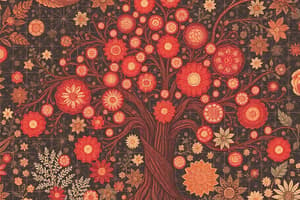Podcast
Questions and Answers
What is the theoretical probability of rolling a 4 on a six-sided die?
What is the theoretical probability of rolling a 4 on a six-sided die?
- 1/2
- 1/6 (correct)
- 1/4
- 1/3
A probability of 0 indicates that an event will certainly happen.
A probability of 0 indicates that an event will certainly happen.
False (B)
Define the term 'sample space' in probability.
Define the term 'sample space' in probability.
The sample space is the list of all possible outcomes for an experiment.
The probability of an event falls within the range of _____ and _____ inclusive.
The probability of an event falls within the range of _____ and _____ inclusive.
Match the types of events with their descriptions:
Match the types of events with their descriptions:
Which of the following is an example of a simple event?
Which of the following is an example of a simple event?
Experimental probability is calculated without conducting trials.
Experimental probability is calculated without conducting trials.
The formula for the probability of two independent events A and B occurring together is P(A ∩ B) = _____ × _____.
The formula for the probability of two independent events A and B occurring together is P(A ∩ B) = _____ × _____.
What is the outcome when flipping a fair coin?
What is the outcome when flipping a fair coin?
What is the probability of rolling an odd number with a fair six-sided die?
What is the probability of rolling an odd number with a fair six-sided die?
Flashcards are hidden until you start studying
Study Notes
Probability Overview
- Probability measures the likelihood of an event occurring.
- Expressed as a number between 0 and 1.
- 0 means the event won't happen.
- 1 means it will definitely happen.
Probability Concepts
- Probability of an event (P(E)) always falls between 0 and 1 (0 ≤ P(E) ≤ 1).
- P(E) = 0: The event is impossible.
- P(E) = 1: The event is certain.
- The closer P(E) is to 1, the more likely the event is to happen.
Example: Tossing a Coin
- The probability of getting heads (P(Heads)) is 0.5.
- This means there's an equal chance of getting heads or tails.
Key Terms
- Experiment: An activity with chance outcomes (e.g., rolling a die).
- Outcome: A possible result of an experiment.
- Sample Space (S): The set of all possible outcomes.
- Event (E): A specific group of outcomes from the sample space.
Example: Rolling a Die
- Experiment: Rolling a six-sided die.
- Outcomes: 1, 2, 3, 4, 5, or 6.
- Sample Space (S): {1, 2, 3, 4, 5, 6}.
- Event (E): Rolling an even number (E = {2, 4, 6}).
Types of Probability
- Experimental Probability: Based on actual trials or observations.
- Theoretical Probability: Based on reasoning and calculations, assuming all outcomes are equally likely.
Events in Probability
- Simple Event: An event with one outcome.
- Compound Event: An event with multiple outcomes.
Types of Compound Events
-
Mutually Exclusive Events (Disjoint): Events that cannot happen at the same time.
- Formula: P(A ∪ B) = P(A) + P(B)
-
Non-Mutually Exclusive Events: Events that can occur together.
- Formula: P(A ∪ B) = P(A) + P(B) - P(A ∩ B)
-
Independent Events: Events where one event doesn't affect the other.
- Formula: P(A ∩ B) = P(A) × P(B)
-
Dependent Events: Events where one event affects the other.
- Formula: P(A ∩ B) = P(A) × P(B|A)
Set Operations
-
Union (A ∪ B): All elements in either set A or set B or both.
- Formula: P(A ∪ B) = P(A) + P(B) - P(A ∩ B)
-
Intersection (A ∩ B): Elements common to both set A and set B.
- Formula: P(A ∩ B) = P(A) × P(B) (for independent events)
Studying That Suits You
Use AI to generate personalized quizzes and flashcards to suit your learning preferences.




